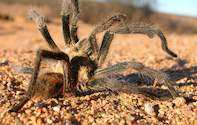
Forget the mammals, birds, reptiles, frogs and other land animals - conservation is not all about the 'big and hairy' but also the 'small and sometimes hairy'. Think about spiders, members of the second most abundant and diverse group of animals that roam the earth.
With more than 5,000 species to choose from in South Africa alone, spiders and their relatives are worth more than a passing glance or a horrified squeak from members of the public, and a new project hopes to get cameras aimed at all the little eight-legged beasties that inhabit the country.
Spiders, scorpions, mites, ticks, whip spiders, false scorpions and sun spiders are all classified as arachnids, and the South African National Survey of Arachnida (Sansa) was launched on September 4, 2006. This four-year inventory is a landmark partnership between the Agricultural Research Council (ARC) and Sanbi (South African National Biodiversity Institute). It partially fulfils South Africa's obligations to the international convention on biological diversity that arose out of the Rio earth summit.
Not only will Sansa try and discover where all of South Africa's arachnids occur and what habitats they prefer, the arachnid inventory will also try and discover which species are threatened with extinction. Heading up the inventory, Professor Ansie Dippenaar-Schoeman says, "Our knowledge of these amazing creatures and where they occur is still sketchy." Spiders play an important and often unrecognised role in many aspects of human lives, acting as pest controllers and important parts of ecosystem processes.
"Sadly," says Wendy Foden of Sanbi's threatened species programme, "we're becoming more aware of arachnids by their increasing absence due to trade in live and dead specimens, the use of pesticides but most seriously due to the destruction of their habitats. For this reason, it is essential that we inventory our arachnids, find out how and where they live, and make plans to protect them."
Members of the public can participate in the arachnid assessment by taking digital photographs of arachnids and submitting them to the project together with accurate locality information. If the photos are good enough to identify the specimen, they become part of a virtual online 'museum'.
Those interested can also contact Sansa for collection bottles and protocols for collecting some of the smaller specimens.
And don't worry about the perils of spider bites while hunting down specimens with your digital camera - statistically speaking, you are more likely to be killed by a champagne cork than by a poisonous spider.
Explore the Letaba Area where the new species of Baboon Spiders was discovered

